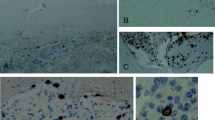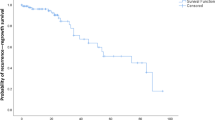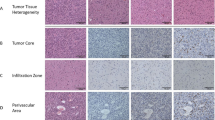Abstract
The aim of this review is to describe the inflammatory systemic cell infiltrate and its role in pathophysiology and prognostic implications of meningiomas. Articles from PubMed describing inflammation and immune cells in meningioma were systematically selected and reviewed. Infiltrating inflammatory cells are common in meningiomas and correlate with tumor behavior and peritumoral edema. The immune cell infiltrate mainly comprised macrophages, CD4 + T cells of the Th1 and Th2 subtype, CD8 + cytotoxic T cells, mast cells, and to a lesser degree B cells. The polarization of macrophages to M1 or M2 states, as well as the differentiation of T-helper cells to Th1 or Th2 subsets, is of prognostic value, but whether or not the presence of macrophages is associated with the degree of malignancy of the tumor is controversial. The best documented immunosuppressive and tumor-promoting mechanism is the expression of programmed cell death protein 1 (PD-1/PD-1L) which is found on both tumor cells and tumor-infiltrating immune cells. The immune cell infiltration varies between different meningiomas. It contributes to a microenvironment with potential contradictory effects on tumor growth and edema. The immune mechanisms are potential therapeutic targets provided that their effects can be comprehensively understood.
Similar content being viewed by others
Data availability
Not applicable.
Code availability
Not applicable.
References
Asai J et al (1999) Fluorescence automatic cell sorter and immunohistochemical investigation of CD68-positive cells in meningioma. Clin Neurol Neurosurg 101(4):229–234. https://doi.org/10.1016/S0303-8467(99)00052-9
Atri C, Guerfali FZ, Laouini D (2018) Role of human macrophage polarization in inflammation during infectious diseases. Int J Mol Sci 19(6). https://doi.org/10.3390/ijms19061801
Baker KJ, Houston A, Brint E (2019) IL-1 family members in cancer; two sides to every story. Front Immunol 10:1197. https://doi.org/10.3389/fimmu.2019.01197
Baxter DS, Orrego A, Rosenfeld JV, Mathiesen T (2014) An audit of immunohistochemical marker patterns in meningioma. J Clin Neurosci Off J Neurosurg Soc Australas 21(3):421–426
Bø L, Mørk SJ, Nyland H (1992) An immunohistochemical study of mononuclear cells in meningiomas. Neuropathol Appl Neurobiol 18(6):548–558. https://doi.org/10.1111/j.1365-2990.1992.tb00825.x
Bougnaud S et al (2016) Molecular crosstalk between tumour and brain parenchyma instructs histopathological features in glioblastoma. Oncotarget 7(22):31955–31971. https://doi.org/10.18632/oncotarget.7454
Caronni N, Savino B, Bonecchi R (2015) Myeloid cells in cancer-related inflammation. Immunobiology Elsevier GmbH 220(2):249–253. https://doi.org/10.1016/j.imbio.2014.10.001
Catakovic K et al (2017) T cell exhaustion: from pathophysiological basics to tumor immunotherapy. Cell Commun Signal 15(1):1. https://doi.org/10.1186/s12964-016-0160-z
Chistiakov DA et al (2017) CD68/macrosialin: not just a histochemical marker, Laboratory investigation; a journal of technical methods and pathology. United States 97(1):4–13. https://doi.org/10.1038/labinvest.2016.116
Domingues PH et al (2013) Association between inflammatory infiltrates and isolated monosomy 22/del(22q) in meningiomas. PLoS ONE 8(10):1–12. https://doi.org/10.1371/journal.pone.0074798
Du Z et al (2015) Increased expression of the immune modulatory molecule PDL1 (CD274) in anaplastic meningioma. Oncotarget 6(7):4704–4716. https://doi.org/10.18632/oncotarget.3082
Esquenazi Y, Lo VP, Lee K (2017) Critical care management of cerebral edema in brain tumors. J Int Care Med US 32(1):15–24. https://doi.org/10.1177/0885066615619618
Fang L et al (2013) The immune cell infiltrate populating meningiomas is composed of mature, antigen-experienced T and B cells. Neuro Oncol 15(11):1479–1490. https://doi.org/10.1093/neuonc/not110
Farhood B, Najafi M, Mortezaee K (2019) CD8(+) cytotoxic T lymphocytes in cancer immunotherapy: a review. J Cell Physiol US 234(6):8509–8521. https://doi.org/10.1002/jcp.27782
Fietta P, Giovanni D (no date) The effector T helper cell triade, 102(2009), pp. 61–74
Frerichs KU et al (1990) Platelet-activating factor and progressive brain damage following focal brain injury. J Neurosurg 73(2):223–233. https://doi.org/10.3171/jns.1990.73.2.0223
Grund S, Schittenhelm J, Roser F, Tatagiba M, Mawrin C, Kim YJ, Bornemann A (2009) The microglial/macrophagic response at the tumour-brain border of invasive meningiomas. Neuropathol Appl Neurobiol England 35(1):82–88. https://doi.org/10.1111/j.1365-2990.2008.00960.x
Han SJ et al (2016) Expression and prognostic impact of immune modulatory molecule PD-L1 in meningioma. J Neuro-Oncol Springer US 130(3):543–552. https://doi.org/10.1007/s11060-016-2256-0
Hanahan D, Weinberg RA (2011) Hallmarks of cancer: the next generation. Cell US 144(5):646–674. https://doi.org/10.1016/j.cell.2011.02.013
Hirashima Y et al (1998) Platelet-activating factor and edema surrounding meningiomas. J Neurosurg 88(2):304–307. https://doi.org/10.3171/jns.1998.88.2.0304
Hou J et al (2013) Peritumoral brain edema in intracranial meningiomas: the emergence of vascular endothelial growth factor-directed therapy. Neurosurg Focus 35(6):1–10. https://doi.org/10.3171/2013.8.FOCUS13301
Hyun-Tak J, Ahmed R, Okazaki T (2010) Role of PD-1 in regulating T-cell immunity. 10.1007/82
Kaba SE et al (1997) The treatment of recurrent unresectable and malignant meningiomas with interferon alpha-2B. Neurosurgery 486(February):271–275. https://doi.org/10.1097/0006123-199702000-00007
Kather JN et al (2017) In silico modeling of immunotherapy and stroma-targeting therapies in human colorectal cancer. Cancer Res US 77(22):6442–6452. https://doi.org/10.1158/0008-5472.CAN-17-2006
Kato Y et al (2014) Clinicopathological evaluation of cyclooxygenase-2 expression in meningioma: immunohistochemical analysis of 76 cases of low and high-grade meningioma. Brain Tumor Pathol Japan 31(1):23–30. https://doi.org/10.1007/s10014-012-0127-8
Kimelberg HK (1995) Current concepts of brain edema: review of laboratory investigations. J Neurosurg 83(6):1051–1059. https://doi.org/10.3171/jns.1995.83.6.1051
Kleihues P et al (2002) The WHO classification of tumors of the nervous system. J Neuropathol Exp Neurol 61(3):215–225. https://doi.org/10.1093/jnen/61.3.215
Knutson KL, Disis ML (2005) Tumor antigen-specific T helper cells in cancer immunity and immunotherapy. Cancer Immunol Immunother CII Germany 54(8):721–728. https://doi.org/10.1007/s00262-004-0653-2
Kumar R et al (2006) Th1/Th2 cytokine imbalance in meningioma, anaplastic astrocytoma and glioblastoma multiforme patients. Oncol Rep 15(6):1513–1516. https://doi.org/10.3892/or.15.6.1513
Lee S, Karas PJ, Hadley CC, Bayley VJC, Khan AB, Jalali A, Sweeney AD, Klisch TJ, Patel AJ (2019) The role of Merlin/NF2 loss in meningioma biology. Cancers (Basel). https://doi.org/10.3390/cancers11111633
Li YD et al (2019) Systemic and local immunosuppression in patients with high-grade meningiomas. Cancer Immunol Immunother Springer Berlin Heidelberg 68(6):999–1009. https://doi.org/10.1007/s00262-019-02342-8
Lim YS et al (2013) Long term clinical outcomes of malignant meningiomas. Brain Tumor Res Treat 1(2):85–90. https://doi.org/10.14791/btrt.2013.1.2.85
Ma X et al (2015) Regulation of IL-10 and IL-12 production and function in macrophages and dendritic cells. F1000Research,4. https://doi.org/10.12688/f1000research.7010.1
Maciel TT, Moura IC, Hermine O (2015) The role of mast cells in cancers. F1000prime Rep 7 9. https://doi.org/10.12703/P7-09
Makino K, Nakamura H, Hide T, Yano S, Kuroda J-I, Iyama K-I, Kuratsu J-I (2012) Fatty acid synthase is a predictive marker for aggressiveness in meningiomas. J Neurooncol 109(2):399–404
Martinez FO Gordon S (2014) The M1 and M2 paradigm of macrophage activation: time for reassessment, F1000prime Rep 6 13. https://doi.org/10.12703/P6-13
Matias D et al (2018) Microglia/astrocytes–glioblastoma crosstalk: crucial molecular mechanisms and microenvironmental factors. Front Cell Neurosci 12(August):1–22. https://doi.org/10.3389/fncel.2018.00235
McGranahan T et al (2019) Current state of immunotherapy for treatment of glioblastoma, Current Treatment Options in Oncology. Curr Treat Opt Oncol 20(3). https://doi.org/10.1007/s11864-019-0619-4
Mirian C, Duun-Henriksen AK, Juratli T et al (2020) Poor prognosis associated with TERT gene alterations in meningioma is independent of the WHO classification: an individual patient data meta-analysis. J Neurol Neurosurg Psychiatry 91(4):378–387
Mirian C, Skyrman S, Bartek JJ, Jensen LR, Kihlström L, Förander P, Orrego A, Mathiesen T (2020) The Ki-67 Proliferation index as a marker of time to recurrence in intracranial meningioma. Neurosurgery. https://doi.org/10.1093/neuros/nyaa226
Moradi A et al (2008) Pathodiagnostic parameters for meningioma grading. J Clin Neurosci Elsevier Ltd 15(12):1370–1375. https://doi.org/10.1016/j.jocn.2007.12.005
Mosser DM, Edwards JP (2008) Exploring the full spectrum of macrophage activation. Nat Rev Immunol 8(12):958–969. https://doi.org/10.1038/nri2448
Murray PJ, Wynn TA (2011) Protective and pathogenic functions of macrophage subsets. Nat Rev Immunol 11(11):723–737. https://doi.org/10.1038/nri3073
Najafi M et al (2019) Macrophage polarity in cancer: a review. J Cell Biochem US 120(3):2756–2765. https://doi.org/10.1002/jcb.27646
Ostrom QT et al (2020) CBTRUS statistical report: primary brain and other central nervous system tumors diagnosed in the United States in 2013–2017. Neuro-oncology 22(12 Suppl 2):iv1–iv96. https://doi.org/10.1093/neuonc/noaa200
Parayath NN, Parikh A, Amiji MM (2018) Repolarization of tumor-associated macrophages in a genetically engineered nonsmall cell lung cancer model by intraperitoneal administration of hyaluronic acid-based nanoparticles encapsulating microRNA-125b. Nano Lett 18(6):3571–3579. https://doi.org/10.1021/acs.nanolett.8b00689
Perry A et al (1999) “Malignancy” in meningiomas: a clinicopathologic study of 116 patients, with grading implications. Cancer US 85(9):2046–2056. https://doi.org/10.1002/(sici)1097-0142(19990501)85:9%3c2046::aid-cncr23%3e3.0.co;2-m
Polyzoidis S et al (2015) Mast cells in meningiomas and brain inflammation, Journal of Neuroinflammation. J Neuroinflammation 12(1):1–8. https://doi.org/10.1186/s12974-015-0388-3
Presta I et al (2017) Innate immunity may play a role in growth and relapse of chordoid meningioma. Int J Immunopathol Pharmacol 30(4):429–433. https://doi.org/10.1177/0394632017730241
Preusser M, Brastianos PK, Mawrin C (2018) Advances in meningioma genetics: novel therapeutic opportunities. Nat Rev Neurol England 14(2):106–115. https://doi.org/10.1038/nrneurol.2017.168
Prinz M, Priller J (2014) Microglia and brain macrophages in the molecular age: from origin to neuropsychiatric disease. Nat Rev Neurosci Nat Pub Group 15(5):300–312. https://doi.org/10.1038/nrn3722
Proctor DT et al (2019) Tumor-associated macrophage infiltration in meningioma Neuro-oncol Adv1(1) vdz018. https://doi.org/10.1093/noajnl/vdz018
Rand RW et al (2000) Intratumoral administration of recombinant circularly permuted interleukin-4-pseudomonas exotoxin in patients with high-grade glioma. Clin Cancer Res 6(6):2157–2165
Rapp C et al (2019) Cytotoxic T cells and their activation status are independent prognostic markers in meningiomas. Clin Cancer Res Official J Am Assoc Cancer Res US 25(17):5260–5270. https://doi.org/10.1158/1078-0432.CCR-19-0389
Reszec J et al (2012) Mast cells evaluation in meningioma of various grades. Folia Histochem Cytobiol 50(4):542–546. https://doi.org/10.5603/FHC.2012.0076
Reszec J et al (2013) Evaluation of mast cells and hypoxia inducible factor-1 expression in meningiomas of various grades in correlation with peritumoral brain edema. J Neurooncol 115(1):119–125. https://doi.org/10.1007/s11060-013-1208-1
Ribatti D (1822) Crivellato E (2012) Mast cells, angiogenesis, and tumour growth. Biochimica et Biophysica Acta - Mol Basis Dis Elsevier BV 1:2–8. https://doi.org/10.1016/j.bbadis.2010.11.010
Roessler K, Dietrich W, Kitz K (1999) Expression of BCL-2 oncoprotein on tumor cells and tumor-infiltrating lymphocytes (TIL) in meningiomas. Neurosurg Rev 22(4):205–209. https://doi.org/10.1007/s101430050017
Rogers L et al (2015) Meningiomas: knowledge base, treatment outcomes, and uncertainties A RANO review. J Neurosurg 122(1):4–23. https://doi.org/10.3171/2014.7.JNS131644
Rossi ML et al (1988) Immunocytochemical study of the cellular immune response in meningiomas. J Clin Pathol 41(3):314–319. https://doi.org/10.1136/jcp.41.3.314
Ruffel B et al (2005) Lymphocytes in cancer development. Bone 23(1):1–7. https://doi.org/10.1038/jid.2014.371
Sato K et al (1995) Expression of monocyte chemoattractant protein-1 in meningioma. J Neurosurg US 82(5):874–878. https://doi.org/10.3171/jns.1995.82.5.0874
Shinonaga M et al (1988) Immunohistological evaluation of macrophage infiltrates in brain tumors. Correlation with peritumoral edema. J Neurosurg 68(2):259–265. https://doi.org/10.3171/jns.1988.68.2.0259
Sica A et al (2008) Macrophage polarization in tumour progression. Sem Cancer Biol England 18(5):349–355. https://doi.org/10.1016/j.semcancer.2008.03.004
Sica A, Mantovani A (2012) Macrophage plasticity and polarization: in vivo veritas. J Clin Investig 122(3):787–795. https://doi.org/10.1172/JCI59643
Simon S, Labarriere N (2017) PD-1 expression on tumor-specific T cells: friend or foe for immunotherapy? Oncoimmunology 7(1):e1364828. https://doi.org/10.1080/2162402X.2017.1364828
Strik HM, Stoll M, Meyermann R (2004) Immune cell infiltration of intrinsic and metastatic intracranial tumours. Anticancer Res 24(1):37–42
Tirakotai W et al (2006) Secretory meningioma: immunohistochemical findings and evaluation of mast cell infiltration. Neurosurg Rev 29(1):41–48. https://doi.org/10.1007/s10143-005-0402-9
Wang B et al (2016) The role and regulatory mechanism of IL-1β on the methylation of the NF2 gene in benign meningiomas and leptomeninges. Mol Carcinog 55(12):2268–2277. https://doi.org/10.1002/mc.22467
Whiteside TL (2008) The tumor microenvironment and its role in promoting tumor growth. Oncogene 27(45):5904–5912. https://doi.org/10.1038/onc.2008.271
Wu CX et al (2015) Peritumoral edema shown by MRI predicts poor clinical outcome in glioblastoma. World J Surg Oncol 13(1):1–9. https://doi.org/10.1186/s12957-015-0496-7
Wu J, Lanier LL (2003) Natural killer cells and cancer. Adv Cancer Res US 90:127–156. https://doi.org/10.1016/s0065-230x(03)90004-2
Wynn TA, Chawla A, Pollard JW (2013) Macrophage biology in development, homeostasis and disease. Nature 496(7446):445–455. https://doi.org/10.1038/nature12034
Xiang W et al (2018) Monoacylglycerol lipase regulates cannabinoid receptor 2-dependent macrophage activation and cancer progression. Nat Commun Springer US 9(1). https://doi.org/10.1038/s41467-018-04999-8
Zadka L et al (2017) Association between interleukin-10 receptors and the CD45-immunophenotype of central nervous system tumors: a preliminary study. Anticancer Res 37(10):5777–5783. https://doi.org/10.21873/anticanres.12019
Zhao J et al (2020) Upregulation of histamine receptor H1 promotes tumor progression and contributes to poor prognosis in hepatocellular carcinoma. Oncogene Springer US 39(8):1724–1738. https://doi.org/10.1038/s41388-019-1093-y
Zhao S et al (2015) Serum IL-10 predicts worse outcome in cancer patients: a meta-analysis. PLoS ONE 10(10):e0139598. https://doi.org/10.1371/journal.pone.0139598
Author information
Authors and Affiliations
Contributions
Writing—original draft preparation: JRM and JHV drafted the original manuscript and share first authorship. Conceptualization: JRM, JHV, TM, FV, and MZ. Validation: MZ. Supervision: JHV, TM, and FV.
Corresponding author
Ethics declarations
Ethics approval
Not applicable.
Consent to participate
Not applicable.
Consent for publication
All authors has given their consent.
Conflict of interest
The authors declare no competing interests.
Additional information
Publisher’s note
Springer Nature remains neutral with regard to jurisdictional claims in published maps and institutional affiliations.
Jeppe Haslund-Vinding and Jens Riis Møller share first authorship.
Appendix
Appendix

Rights and permissions
About this article
Cite this article
Haslund-Vinding, J., Møller, J.R., Ziebell, M. et al. The role of systemic inflammatory cells in meningiomas. Neurosurg Rev 45, 1205–1215 (2022). https://doi.org/10.1007/s10143-021-01642-x
Received:
Revised:
Accepted:
Published:
Issue Date:
DOI: https://doi.org/10.1007/s10143-021-01642-x




